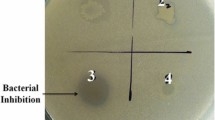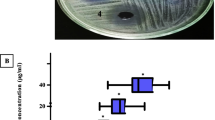Abstract
Staphylococcal wound infections range from mild to severe with life-threatening complications. The challenge of controlling such infections is related to bacterial biofilm formation, which is a major factor contributing to antibiotic resistance and infection recurrence. In this study, four clinical isolates of staphylococci species; two isolates of methicillin-resistant Staphylococcus aureus (MRSA) and two methicillin-sensitive Staphylococcus aureus (MSSA) isolates. The identification of bacterial species based on cell morphology, initial biochemical tests, and the VITEK2 system were used to confirm the clinical microbiological diagnosis. Antibiotic sensitivity testing showed that the isolated staphylococci were highly resistant to the following antibiotics, amoxicillin, penicillin G, cefotaxime, and methicillin. Combinations of cefotaxime with the cell-free supernatants (CFS) of Bacillus subtilis KATMIRA1933 and Bacillus amyloliquefaciens B-1895, each one separately showed complementary activity against the tested staphylococci. The co-aggregation capability of the tested bacilli as beneficial bacteria against isolated staphylococci was also evaluated. The data showed a strong co-aggregation with scores (+ 3, + 4) which were reported between the bacilli strains and the isolated staphylococci. Furthermore, the CFS of bacilli strains showed an inhibitory effect against biofilm-associated MRSA and MSSA. These findings confirmed the ability of beneficial bacteria to compete with the pathogens at the site of colonization or for the source of nutrients and, eventually, lead to inhibition of the pathogens’ capability of causing a wound infection. Such beneficial bacteria could play an important role in future pharmaceutical and industrial applications.



Similar content being viewed by others
References
Brackman G, De Meyer L, Nelis HJ, Coenye T (2013) Biofilm inhibitory and eradicating activity of wound care products against Staphylococcus aureus and Staphylococcus epidermidis biofilms in an in vitro chronic wound model. J Appl Microbiol 114(6):1833–1842. https://doi.org/10.1111/jam.12191
Miller LS, Cho JS (2011) Immunity against Staphylococcus aureus cutaneous infections. Nature Rev Immunol 11(8):505–518. https://doi.org/10.1038/nri3010
Lowy FD (1998) Staphylococcus aureus infections. N Engl J Med 339(8):520–532. https://doi.org/10.1056/NEJM199808203390806
Persoons D, Van Hoorebeke S, Hermans K, Butaye P, de Kruif A, Haesebrouck F, Dewulf J (2009) Methicillin-resistant Staphylococcus aureus in poultry. Emerg Infect Dis 15(3):452–453. https://doi.org/10.3201/eid1503.080696
Tobin MR, Goldshear JL, Price LB, Graham JP, Leibler JH (2015) A framework to reduce infectious disease risk from urban poultry in the United States. Public Health Rep 130(4):380–391. https://doi.org/10.1177/003335491513000417
Dall'Antonia M, Coen PG, Wilks M, Whiley A, Millar M (2005) Competition between methicillin-sensitive and -resistant Staphylococcus aureus in the anterior nares. J Hosp Infect 61:62–67. https://doi.org/10.1016/j.jhin.2005.01.008
Fitzpatrick F, Humphreys H, O'Gara JP (2005) The genetics of staphylococcal biofilm formation—will a greater understanding of pathogenesis lead to better management of device-related infection? Clin Microbiol Infect 11:967–973. https://doi.org/10.1111/j.1469-0691.2005.01274.x
Algburi A, Comito N, Kashtanov D, Dicks LM, Chikindas ML (2017a) Control of biofilm formation: antibiotics and beyond. Appl Environ Microbiol 83(3):e02508–e02516. https://doi.org/10.1128/AEM.02508-16
Sutyak KE, Wirawan R, Aroutcheva A, Chikindas M (2008) Isolation of the Bacillus subtilis antimicrobial peptide subtilosin from the dairy product-derived Bacillus amyloliquefaciens. J Appl Microbiol 104(4):1067–1074. https://doi.org/10.1111/j.1365-2672.2007.03626.x
Noll KS, Prichard MN, Khaykin A, Sinko PJ, Chikindas ML (2012) The natural antimicrobial peptide subtilosin acts synergistically with glycerol monolaurate, lauric arginate and ε-poly-L-lysine against bacterial vaginosis-associated pathogens but not human lactobacilli. Antimicrob agents Chemother 56(4):1756–1761. https://doi.org/10.1128/AAC.05861-11
Van Kuijk S, Noll KS, Chikindas ML (2012) The species-specific mode of action of the antimicrobial peptide subtilosin against Listeria monocytogenes Scott A. Lett App Microbiol 54(1):52–58. https://doi.org/10.1111/j.1472-765X.2011.03170.x
Algburi A, Volski A, Cugini C, Walsh EM, Chistyakov VA, Mazanko MS, Bren AB, Dicks LM, Chikindas ML (2016) Safety properties and probiotic potential of Bacillus subtilis KATMIRA1933 and Bacillus amyloliquefaciens B-1895. Adv Microbiol 6(06):432–452. https://doi.org/10.4236/aim.2016.66043
Algburi A, Alazzawi SA, Al-Ezzy AIA, Weeks R, Chistyakov V, Chikindas ML (2020) Potential probiotics Bacillus subtilis KATMIRA1933 and Bacillus amyloliquefaciens B-1895 co-aggregate with clinical isolates of Proteus mirabilis and prevent biofilm formation. Probiotics Antimicrob Prot. https://doi.org/10.1007/s12602-020-09631-0 [ahead of print]
Golovko GV, Zipelt LI, Karpenko GI, Chistyakov VA, Sazykina MA, Kolenko MA (2008) Method for growth of young Azov-Chernomorskaya royal fish in ponds. RU patent no. 2376755. https://patents.google.com/patent/RU2376755C1/en. Accessed on 21 Apr, 2020
Chistyakov V, Melnikov V, Chikindas ML, Khutsishvili M, Chagelishvili A, Bren A, Kostina N, Cavera V, Elisashvili V (2015) Poultry-beneficial solid-state Bacillus amyloliquefaciens B-1895 fermented soybean formulation. Biosci microbiota food health 3:25–28. https://doi.org/10.12938/bmfh.2014-012
Prazdnova EV, Chistyakov VA, Churilov MN, Mazanko MS, Bren AB, Volski A, Chikindas ML (2015) DNA-protection and antioxidant properties of fermentates from Bacillus amyloliquefaciens B-1895 and Bacillus subtilis KATMIRA1933. Lett Appl Microbiol 61:549–554. https://doi.org/10.1111/lam.12491
Mazanko MS, Gorlov IF, Prazdnova EV, Makarenko MS, Usatov AV, Bren AB, Chistyakov VA, Tutelyan AV, Komarova ZB, Mosolova NI, Pilipenko DN, Krotova OE, Struk AN, Lin A, Chikindas ML (2018) Bacillus probiotic supplementations improve laying performance, egg quality, hatching of laying hens, and sperm quality of roosters. Probiotics Antimicrob Proteins 10(2):367–373. https://doi.org/10.1007/s12602-017-9369-4
Prazdnova EV, Mazanko MS, Chistyakov VA, Denisenko YV, Makarenko MS, Usatov AV, Bren AB, Tutelyan AV, Komarova ZB, Gorlov IF, Weeks R, Chikindas ML (2019) Effect of Bacillus subtilis KATMIRA1933 and Bacillus amyloliquefaciens B-1895 on the productivity, reproductive aging, and physiological characteristics of hens and roosters. Benef Microbes 10(4):395–412. https://doi.org/10.3920/BM2018.0149
Ledder RG, Timperley AS, Friswell MK, Macfarlane S, McBain AJ (2008) Coaggregation between and among human intestinal and oral bacteria. FEMS Microbiol Ecol 66:630–636. https://doi.org/10.1111/j.1574-6941.2008.00525.x
Kos B, Suskovic J, Vukovic S, Simpraga M, Frece J, Matosic S (2003) Adhesion and aggregation ability of probiotic strain Lactobacillus acidophilus M92. J Appl Microbiol 94:981–987. https://doi.org/10.1046/j.1365-2672.2003.01915.x
Schachter B (2003) Slimy business-the biotechnology of biofilms. Nat Biotechnol 21:361–365. https://doi.org/10.1038/nbt0403-361
Annous BA, Fratamico PM, Smith JL (2009) Quorum sensing in biofilms: why bacteria behave the way they do. J Food Sci 74:R24–R37. https://doi.org/10.1111/j.1750-3841.2008.01022.x
Algburi A, Zehm S, Netrebov V, Bren AB, Chistyakov V, Chikindas ML (2017b) Subtilosin prevents biofilm formation by inhibiting bacterial quorum sensing. Probiotics Antimicrob Proteins 9(1):81–90. https://doi.org/10.1007/s12602-016-9242-x
Clinical and Laboratory Standards Institute (2016) Performance standards for antimicrobial susceptibility testing; twenty–second informational supplement. CLSI Document M 100- S26, Wayne
Cisar JO, Kolenbrander PE, McIntire FC (1979) Specificity of coaggregation reactions between human oral streptococci and strains of Actinomyces viscosus or Actinomyces naeslundii. Infect Immun 24(3):742–752
Borucki MK, Peppin JD, White D, Loge F, Call DR (2003) Variation in biofilm formation among strains of Listeria monocytogenes. Appl Environ Microbiol 69(12):7336–7342. https://doi.org/10.1128/AEM.69.12.7336-7342.2003
Qiu J, Wang D, Zhang Y, Dong J, Wang J, Niu X (2013) Molcular modeling reveals the novel inhibition mechanism and binding mode of three natural compounds to staphylococcal alpha-hemolysin. PLoS One 8(11):e80197. https://doi.org/10.1371/journal.pone.0080197
Naimi HM, Rasekh H, Noori AZ, Bahaduri MA (2017) Determination of antimicrobial susceptibility patterns in Staphylococcus aureus strains recovered from patients at two main health facilities in Kabul, Afghanistan. BMC Infect Dis 17(1):737. https://doi.org/10.1186/s12879-017-2844-4
Chinnambedu RS, Marimuthu RR, Sunil SS, Amrose P, Ramachandran V, Pachamuthu B (2020) Changing antibiotic resistance profile of Staphylococcus aureus isolated from HIV patients (2012–2017) in Southern India. J Infect Public Health 31:75–79. https://doi.org/10.1016/j.jiph.2019.06.015
Lee JS, Chung MJ, Seo JG (2013) In vitro evaluation of antimicrobial activity of lactic acid bacteria against Clostridium difficile. Toxicol Res 29(2):99–106. https://doi.org/10.5487/TR.2013.29.2.099
Mariam SH, Zegeye N, Tariku T, Andargie E, Endalafer N, Aseffa A (2014) Potential of cell-free supernatants from cultures of selected lactic acid bacteria and yeast obtained from local fermented foods as inhibitors of Listeria monocytogenes, Salmonella spp. and Staphylococcus aureus. BMC res notes 7:606. https://doi.org/10.1186/1756-0500-7-606
Aminnezhad S, Kermanshahi RK, Ranjbar R (2015) Evaluation of synergistic interactions between cell-free supernatant of Lactobacillus strains and amikacin and genetamicin against Pseudomonas aeruginosa. Jundishapur J Microbiol 8(4):e16592. https://doi.org/10.5812/jjm.8(4)2015.16592
Moghadam SS, Khodaii Z, Zadeh SF, Ghooshchian M, Aghmiyuni ZF, Shabestari TM (2018) Synergistic or antagonistic effects of probiotics and antibiotics-alone or in combination-on antimicrobial-resistant Pseudomonas aeruginosa isolated from burn wounds. Arch Clin Infect Dis 13(3). https://doi.org/10.5812/archcid.6312
Rishi L, Mittal G, Agarwal RK, Sharma T (2017) Melioration in anti-staphylococcal activity of conventional antibiotic (s) by organic acids present in the cell free supernatant of Lactobacillus paraplantarum. Indian J Microbiol 57(3):359–364. https://doi.org/10.1007/s12088-017-0659-z
Kok ET, Jong MC, Gravendeel B, Van Leeuwen WB, Baars EW (2015) Resistance to antibiotics and antifungal medicinal products: can complementary and alternative medicine help solve the problem in common infection diseases? The introduction of a dutch research consortium. Evid Based Complement Alternat Med 2015:521584–521586. https://doi.org/10.1155/2015/521584
Gokarn K, Pal RB (2018) Activity of siderophores against drug-resistant gram-positive and gram-negative bacteria. Infect Drug Resist 1:61–75. https://doi.org/10.2147/IDR.S148602
Abd El-Baky RM, Sandle T, John J, Abuo-Rahma GEA, Hetta HF (2019) A novel mechanism of action of ketoconazole: inhibition of the NorA efflux pump system and biofilm formation in multidrug-resistant Staphylococcus aureus. Infect Drug Resist 12:1703–1718. https://doi.org/10.2147/IDR.S201124
Algburi A, Volski A, Chikindas ML (2015) Natural antimicrobials subtilosin and lauramide arginine ethyl ester synergize with conventional antibiotics clindamycin and metronidazole against biofilms of Gardnerella vaginalis but not against biofilms of healthy vaginal lactobacilli. Pathog dis 73(5). https://doi.org/10.1093/femspd/ftv018
Younes JA, van der Mei HC, van den Heuvel E, Busscher HJ, Reid G (2012) Adhesion forces and coaggregation between vaginal staphylococci and lactobacilli. PLoS One 7(5):e36917. https://doi.org/10.1371/journal.pone.0036917
Jain N, Meta A, Bharti V (2017) Screening, characterization, and in vitro evaluation of probiotic properties of Lactobacillus strains. Asian J pharm and Clin Res 10(8):288. https://doi.org/10.22159/ajpcr.2017.v10i8.14233
Soleimani NA, Kermanshahi RK, Yakhchali B, Sattari TN (2010) Antagonistic activity of probiotic lactobacilli against Staphylococcus aureus isolated from bovine mastitis. African J Microbiol Res 4(20):2169–2173
Zamani H, Rahbar S, Garakoui SR, Afsah Sahebi A, Jafari H (2017) Antibiofilm potential of Lactobacillus plantarum spp. cell free supernatant (CFS) against multidrug resistant bacterial pathogens. Pharm Biomed Res 3(2):39–44. https://doi.org/10.29252/pbr.3.2.39
Khiralla GM, Mohamed EA, Farag AG, Elhariry H (2015) Antibiofilm effect of Lactobacillus pentosus and Lactobacillus plantarum cell-free supernatants against some bacterial pathogens. J Biotech Res 6:86–95
Satpute S, Mone N, Das P, Banpurkar A, Banat I (2018) Lactobacillus acidophilus derived biosurfactant as a biofilm inhibitor: a promising investigation using microfluidic approach. Appl Sci 8(9):1555. https://doi.org/10.3390/app8091555
Wong CB, Khoo BY, Sasidharan S, Piyawattanametha W, Kim SH, Khemthongcharoen N, Ang MY, Chuah LO, Liong MT (2014) Inhibition of Staphylococcus aureus by crude and fractionated extract from lactic acid bacteria. Benef Microbes 6(1):129–139. https://doi.org/10.3920/BM2014.0021
Koohestani M, Moradi M, Tajik H, Badali A (2018) Effects of cell-free supernatant of Lactobacillus acidophilus LA5 and Lactobacillus casei 431 against planktonic form and biofilm of Staphylococcus aureus. Vet res forum 9(4):301–306. https://doi.org/10.30466/vrf.2018.33086
Hor YY, Liong MT (2014) Use of extracellular extracts of lactic acid bacteria and bifidobacteria for the inhibition of dermatological pathogen Staphylococcus aureus. Dermatol Sinica 32(3):141–147. https://doi.org/10.1016/j.dsi.2014.03.001
Acknowledgements
The authors would like to acknowledge the deanery of the Science College, University of Diyala and the General Teaching Hospital in Baqubah, Iraq, for providing free access to their equipment and facilities required for this study and for providing us with clinical isolates of MRSA and MSSA, as a gift.
Funding
AME and MLC were supported by the Ministry of Science and Higher Education of the Russian Federation (Project Number 075-15-2019-1880).
Author information
Authors and Affiliations
Corresponding author
Ethics declarations
Conflict of Interest
The authors declare that they have no conflict of interest.
Additional information
Publisher’s Note
Springer Nature remains neutral with regard to jurisdictional claims in published maps and institutional affiliations.
Rights and permissions
About this article
Cite this article
Algburi, A., Al-Hasani, H.M., Ismael, T.K. et al. Antimicrobial Activity of Bacillus subtilis KATMIRA1933 and Bacillus amyloliquefaciens B-1895 Against Staphylococcus aureus Biofilms Isolated from Wound Infection. Probiotics & Antimicro. Prot. 13, 125–134 (2021). https://doi.org/10.1007/s12602-020-09673-4
Published:
Issue Date:
DOI: https://doi.org/10.1007/s12602-020-09673-4




